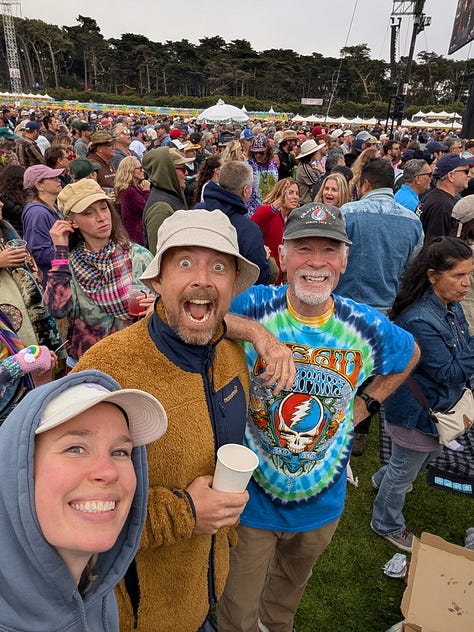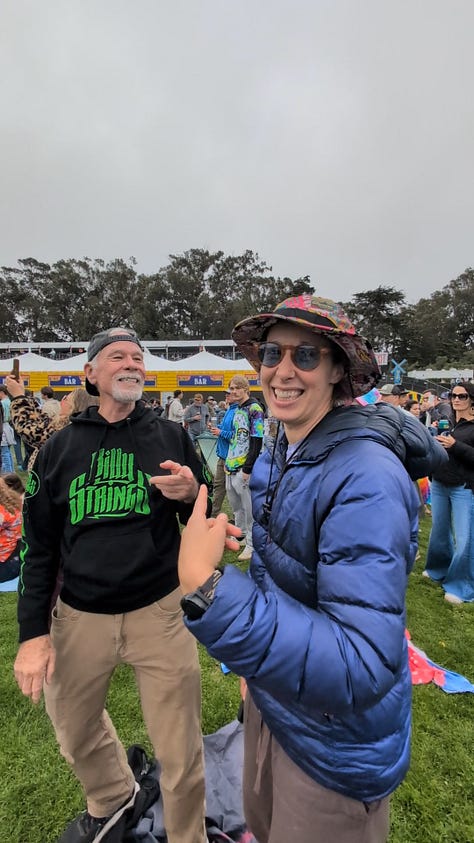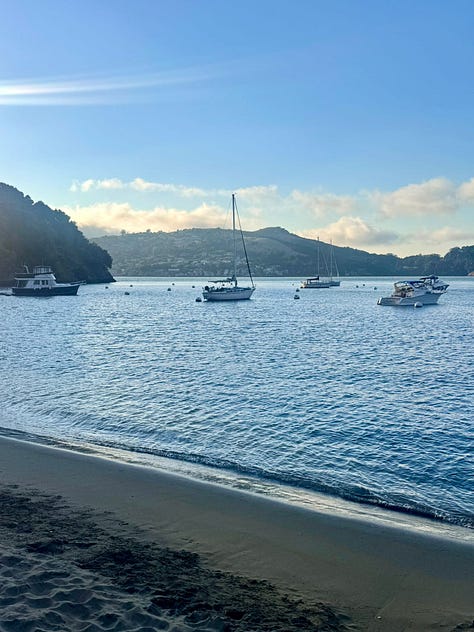Heyyyyy! It's been a minute!
Summer break has been a whirlwind — kids home, work in full swing, and just enough fun to keep me on my toes.
Highlights from the chaos:
Angel Island sailing adventure – My sister and her partner came up for a weekend sailing trip to Angel Island. It was absolutely freezing (hello, Bay Area summer), but we successfully practiced mooring without anyone having a meltdown which felt like a genuine victory. The hike around the island was gorgeous, and we stumbled upon the most delightful bike tour guide who made the whole experience magical. Seriously, if you ever make it to Angel Island, look for the bike tours — totally worth it.
Sailing trip to Catalina – What was supposed to be an epic sailing trip to Catalina a few weekends ago turned into a smoke-filled excursion. We didn't even make it out of the marina before the engine overheated. So instead of our grand adventure, we sailed around for a few hours, came back in, and spent the next day troubleshooting with ChatGPT. (Turns out it probably was a thermostat issue — helpful, but not "let's grab a wrench and do this ourselves" helpful.) The silver lining? An afternoon of live music and cold drinks in the park.
GD60 in San Francisco – My dad and sister came to SF for the Grateful Dead's 60th anniversary party. We danced our way through Billy Strings, Sturgill Simpson, Trey Anastasio, and Dead & Company over three days. My body hurt, but my soul is properly recharged.
Summer with four kids – While most of their summer is spent in Europe with their extended family (are you as jealous as I am?), having them home these last few weeks has really made me wonder how people do this full time! But we've had so much fun including a backpacking trip, horseback riding excursion, and tubing on the Russian River.



Next on deck: Sailing Classes!! ASA104 — the class that will technically let me bareboat charter a sailboat. In other words: they will hand me the keys and trust I won't immediately smash the boat into the nearest dock. Over the next two weekends, I'll prove I can rescue some milk jugs named "Chuck and Bob" (the man-overboard test) tie a bunch of knots, and prove that I make the best boat snacks known to man.
Naturally, instead of studying like a responsible sailor, I started… building something to help me study. Kind of…
Enter: Bay Area Sailing (and the Loveable Experiment)
If you have been following this substack, you know I've been using Cursor for months now. We've had some good times, but the constant break/fix/break loop was getting old and unmotivating. And the whole vibe felt a bit... condescending? Like it assumed I should already know things I definitely didn't know. The dark mode code-only interface screamed SF TECH BRO which was cool at first but became annoying after a while.
So when I heard about Loveable, I decided to give it a spin.
Here's where my brain went: Product managers of a certain vintage will remember the before times — when we wrote 100+ page requirement documents, waited months (sometimes years) for dev teams to deliver, and then found out one requirement was ambiguous and now everything worked differently than we imagined.
Then came Agile, or at least "Agile-ish." Smaller scope, constant check-ins, MVP first, polish later (if you're lucky).
But with AI? I wondered if we might ditch MVP thinking altogether — if we could build more, faster, and better, right from the start.
The reality? Not quite. But it was a fun experiment!
The Loveable Experience
What I liked about Loveable:
Beautiful interface with the prototype right next to the chat. Toggle to code view when you want.
Easy to tweak features mid-stream — I ended up adding way more than I'd normally put in an MVP: weather conditions, knot instructions, boating checklists.
Full Supabase integration made setup and debugging way smoother.
What I didn't love:
The prettier look and feel didn't get rid of that all too familiar feeling of "this should work but doesn't" that I know so well from Cursor.
It didn't tell me up front that I'd need an API, so I had to figure that out mid-build.
Some setup instructions weren't quite right — I had to stumble my way to fixes that should have been straightforward.
I wired in the weather API, deployed my project, and… drum roll… Errors.
But hey — it's a start. If you're sailing in the Bay Area, maybe one day soon you'll see it in action:
https://bay-sail-guide.lovable.app
What I'm Learning (From My Mistakes and Other People's Wins)
After my latest round of "why doesn't this work?" I did what any reasonable person does when their code breaks: I went spelunking through other people's experiences to figure out what I'm doing wrong.
Turns out, there's a guy who's spent 200+ hours with Loveable and learned some things I wish I'd known before I dove in.
I jumped straight to "make me the thing." Apparently, that's not how you get the best results. The people who are actually successful with AI tools spend time helping the AI understand the problem space first, not just the feature list. Instead of "build me a sailing app," it's more like "I'm studying for a sailing certification and need to track weather, practice knots, and run through safety checklists — help me think through what that could look like."
This makes sense. It's like the difference between telling a developer "build me a button" versus explaining the user journey and letting them suggest the right interaction. The AI, it turns out, is actually pretty good at exploring solutions if you give it the right context. I will say though, it is really hard when the pretty prototype is right there waiting to be published!!
I should have been documenting as I went. Loveable can save its reasoning process in a /docs folder, creating what this guy called "persistent memory." When you inevitably hit errors (like I did), you're not starting from scratch every time. You have context. You have a trail of decisions. We learned this with Cursor, so I should have remembered how useful it was before and brought that over with me. But somehow when I'm "just tinkering" with AI tools, I forget all my PM best practices and just wing it.
I treated it like a magic wand instead of a thinking partner. The most successful approach seems to be working in cycles: expand (let it explore possibilities), refine (focus on what works), integrate (document the learnings). I basically did the opposite — jumped straight to "build the thing" and got frustrated when it didn't work perfectly on the first try.
This is probably the biggest shift for me. I keep thinking AI development is about replacing the product process, but it's actually about compressing it. You still need to think through user needs and system architecture and edge cases. You just get to do it in conversation instead of in 100-page documents.
I was too cheap with the credits. Multiple people mentioned this: it's worth spending extra credits upfront to really nail the foundation. The alternative is what I experienced — a half-working app that needs debugging I'm not equipped to do.
This is such a product manager thing to say, but: sometimes the fast/cheap option costs more in the long run.
The Bigger Picture
Here's what I keep coming back to: I spent three months building a Danish practice app with Cursor. It worked great until it didn't, and when it broke, I felt like I'd lost everything.
But when I started this sailing app with Loveable, I wasn't starting from zero. I knew more about APIs and deployment and how to talk to AI tools. The failure wasn't wasted time — it was education.
And honestly? Even though my sailing app has errors, I'm still learning faster than I ever have. I'm building things (however imperfectly) that help me solve real problems. I'm not waiting for dev time or budget approval or the perfect requirements document.
I'm just building.
What's Next
I'm going back to fix my sailing app properly this time. Armed with these insights, I plan to start over with better problem definition and let Loveable help me think through the solution space more thoroughly.
And yes, I'll actually study for my sailing certification too. Chuck and Bob are counting on me.
The truth is, I'm still in that special place where I'm too stubborn to give up but too confused to know exactly what to do next. But I'm documenting it all here — the wins, the disasters, and especially the moments when vibe coding feels less like magic and more like controlled chaos.
If you're on a similar journey, you're not alone. We're all just figuring it out as we go.
Thanks for reading! If you've experimented with AI development tools and have wisdom to share (or disasters to commiserate about), I'd love to hear from you.




